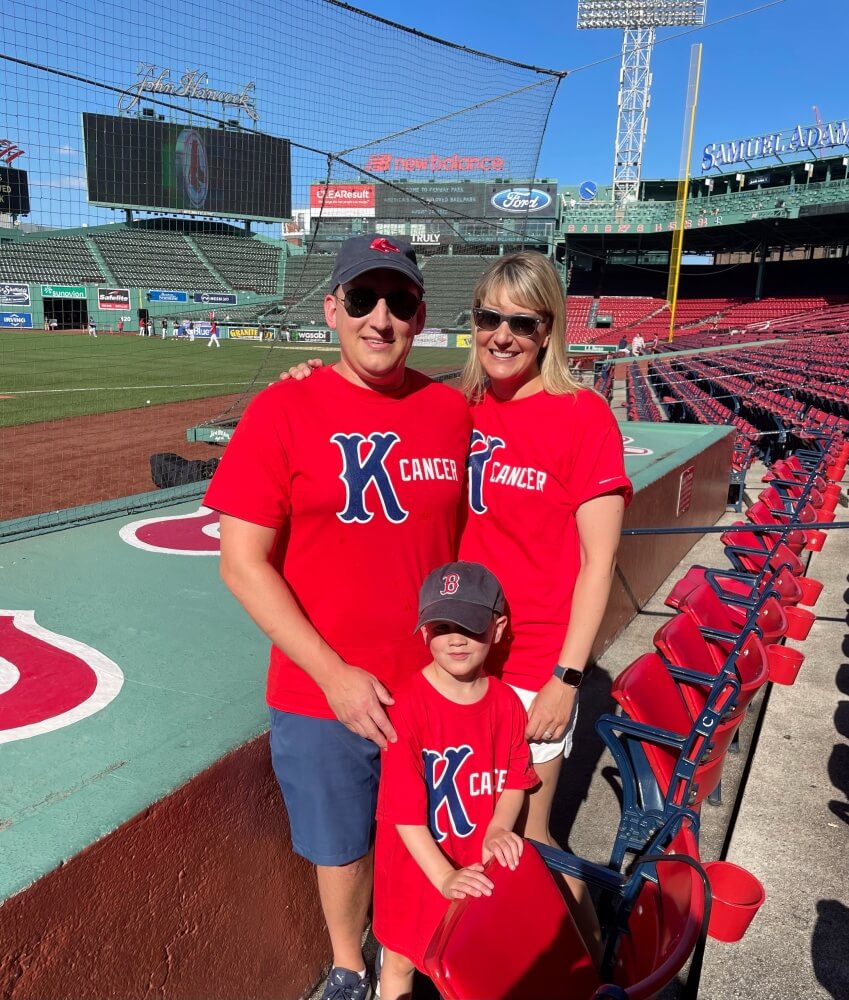Jared Olinski was lifting his four-year-old son off of the floor when he felt three sharp pops in his back followed by pain. At first, cancer wasn’t on his radar. Olinksi was only 35 at the time.
“I assumed I pulled a muscle,” Olinski remembers.
His primary care physician thought it was a slipped disk and prescribed physical therapy. But Olinski’s pain continued to worsen to the point where he could no longer walk.
It was the weekend after Thanksgiving in 2021 when Jared Olinski and his wife, Amanda Newton, rushed to their local hospital in Western Massachusetts. There, an MRI scan revealed a tumor in his spinal cord.
“The tumor pushing on my spinal cord was blocking signals from my brain to getting to the lower part of my body,” Olinski explains.
He was quickly transferred to Baystate Medical Center for an emergency surgery to attempt to decompress his spinal cord and to perform a biopsy. The team there told Olinski he had an aggressive, quick-growing cancer, and he needed treatment immediately. He decided to seek care at Dana-Farber Cancer Institute, where Newton’s cousin also worked.

A cancer Dana-Farber is built to handle
Still unsure exactly what type of lymphoma Jared had, Olinski and Newton met with Dana-Farber’s Ben Lampson, MD, PhD. The expert team of pathologists and radiologists in the Dana-Farber Lymphoma Program, quickly identified that Olinski had a rare lymphoma called Burkitt lymphoma.
Burkitt lymphoma can appear in young adults and often affects the nervous system. Since the tumors grow quickly, pain at the location of the tumor is also often a symptom. Some patients might present with other indicators commonly associated with other lymphomas such as enlarged lymph nodes and unexplained weight loss.
A normal white blood cell goes through a life cycle of birth and death. Lymphomas are caused by errors in the DNA of those blood cells, which keeps them from dying.
“The specific error that marks Burkitt lymphoma doesn’t just tell the cell not to die, but it will also make it rapidly replicate,” Lampson explains.
Despite this concerning news, Olinski and Newton were reassured by the Dana-Farber team that it was a treatable cancer.
“When I first met Olinski, I thought: This is exactly the type of case that Dana-Farber was built to handle,” says Lampson. “It’s a rare tumor with a complicated presentation, and it’s going to require input from many disciplines — pathology to neurology and physical therapy.”
Olinksi was immediately admitted into Dana-Farber’s Inpatient Hospital located at Brigham and Women’s Hospital for monitoring while he received intensive chemotherapy treatment.

The challenges of admission
Olinski’s care team tracked his progress on a whiteboard in his hospital room to help his family understand what was happening.
“The doctors and nurses were really great about explaining each treatment and procedure,” says Newton. “I had a lot of anxiety, but they took so much time to answer questions and offer comfort.”
A long-term stay in the hospital was not only hard for Olinski, but for his family as well. Olinski’s son, Jamie, was very close with his father and having him away from home proved difficult.
“The three of us were like a little pod,” Newton explains.
“Jamie got really attached to Amanda, and it was difficult for him when she would come to visit me,” Jared Olinski adds.
Visitation was also limited during this time due to COVID-19. Only two visitors were allowed during specific hours to help prevent the spread of the virus, which can be especially dangerous to immunocompromised patients like Olinski.
In total, Jared Olinski spent three months away from home in treatment and recovery. Between treatment rounds, he spent Christmas in a physical rehabilitation hospital, working on getting his mobility back.
“That was really tough,” Newton remembers.
However, she and Jamie visited and called as much as possible. The young parents were also fortunate enough to be able to lean on their local community, including parents and friends, to help care for their son. Olinski attributes getting through those months to his family’s support.
“Jared was so fantastic throughout treatment,” Lampson remembers. “He was very motivated and had a tremendous amount of family support.”
Beyond lymphoma
After four rounds of chemotherapy, Olinski was cancer free, but his recovery didn’t end there. Returning to full mobility after spinal cord damage requires a lot of physical therapy, hard work, and patience.
“That was a much longer road than expected,” he says.
Fortunately, Olinski has made tremendous progress and is back on his feet. His son is his biggest cheerleader.
“Nowadays he’ll tell me, ‘Daddy, that’s a good challenge for you,’ when I attempt something new,” Olinski laughs. “The first time I was able to shoot a basketball again he was so happy. I’ve gained a new appreciation for life, my family, and my friends, and the things that I took for granted.”
